The 25th anniversary of the fall of the Berlin Wall
Saturday and Sunday, November 8 & 9,2014
Part1
On the weekend of Saturday and Sunday, November 8 & 9, 2014 I was keeping my attention on Television watching the 25th anniversary of the fall of the Berlin Wall especially on the BBC News and Euro News. I was very glad to see German people celebrating the event and all the Europeans were having good time seeing East and West Germany unite into one country. I also went on the internet to read the articles and seeing photographs of the cerebration of the event from different news websites. I was glad and appreciated the entire medium, published the articles had wonderful pictures. Since I spent a lot of time reading articles and viewing a lot of pictures of the event I would like others to view them also. Some people might not have time to see as many articles as I have. It is might be useful to teachers to show to their students in the classroom.
The 25th anniversary of the fall of the Berlin Wall is as importance as the period that the wall was up separating people from east and west. It can show people who are fighting and killing each other in the present that compromise and willingness to have peace can be achieved. The German people achieved unification without bloodshed. They are now prosperous and have freedom to travel from East and West. There is no longer the sadness of separation from family and friends. They have freedom of movement without killing anyone.
There is no wall high enough and long enough to confine people because people’s will power is higher and stronger than any partition that impounds them.
“Chancellor Angela Merkel attended a service for victims of the communist East German regime, and will go to a huge party at the Brandenburg Gate.
In her speech at the wall memorial on Bernauer Strasse on Saturday afternoon, Germany’s chancellor, Angela Merkel, had explicitly emphasised the geopolitical resonances of the event, instead of indulging in personal reminiscences.”
“We have the strength to shape things, to turn things from bad to good, that is the message of the fall of the wall,” she said. “These days, that message is directed at Ukraine, Syria, Iraq and many, many other regions in the world.” (From BBC News)
This event is very good news for the whole world. Killing and fighting is uncivilized and causes trouble not only in one country or one region but affects the entire world in a domino or ripple affect. We hear bad news from all over the world every day and every minute of the news.
You cannot kill every one of your enemies. It is impossible. The only thing left is to survive with one another by making your enemy become your friend. Over the past few years Syrians have killed each other with more than 200,000 people dead, including children, women and men. How many more people do Syrians want to kill on all sides, five hundred thousand or million more? Or do they want to surpass Hitler. His regime killed more than twenty one million people (Wikipedia). It will never end if Syrians keep killing and hating each other. They will never give happiness and a good future to their children and family. So why are they killing each other? Can Syria, Iraq, Egypt, Libya, and others learn from Germany? Find out how the German people united and helped each other to become prosperous rather than divided and destructive to their country.
Ing-On Vibulbhan-Watts, Thursday, November 20, 2014
The followings are the articles and photographs from different media:
BBC News on 11.9.14
Berlin Wall: Thousands of balloons released to mark fall
The balloons were released into the Berlin night sky, as Jenny Hill reports
Some 8,000 helium balloons have been released into the night sky over Germany’s capital at the culmination of events to mark the 25th anniversary of the fall of the Berlin Wall.
Earlier, Chancellor Angela Merkel said the fall of the wall had shown the world that dreams could come true.
Tens of thousands of people attended events, including a “citizen’s party” at the Brandenburg Gate.
The Berlin Wall was built in 1961 to stop people fleeing the communist East.
Its fall in 1989 became a powerful symbol of the end of the Cold War.
The white balloons – perched on 3.6m poles to match the height of the wall and stretching for 15km (nine miles) – were released one by one to symbolise its disappearance.
Chancellor Angela Merkel places a rose in a remaining section of the wall
The Berlin State Orchestra under Daniel Barenboim played Beethoven’s Ode to Joy.
The release came amid a massive open-air party at the Brandenburg Gate. Earlier at the party, UK performer Peter Gabriel sang a version of David Bowie’s Heroes.
At the scene: Damian McGuinness, BBC News
For a weekend the balloons had become a part of the city, with Berliners strolling, jogging or cycling along the route.
Today not much of the Wall remains, and often you don’t even notice when crossing between East and West. That’s because, after 1989, Berliners wanted to destroy the much-hated barrier and rebuild their city.
But suddenly seeing the circuitous and often illogical line which tore through the city’s heart was a reminder of the insanity of using concrete to split a city in two, dividing neighbourhoods, friends and families.
Now the balloons have floated off into the sky, each one accompanied by cheers from the crowd – a shining and delicate symbol of peace and light, in stark contrast to the brutality of the heavy slabs of grey concrete. And a powerful reminder of how 25 years ago, under pressure from ordinary Berliners, this deadly barrier suddenly lost its threat.
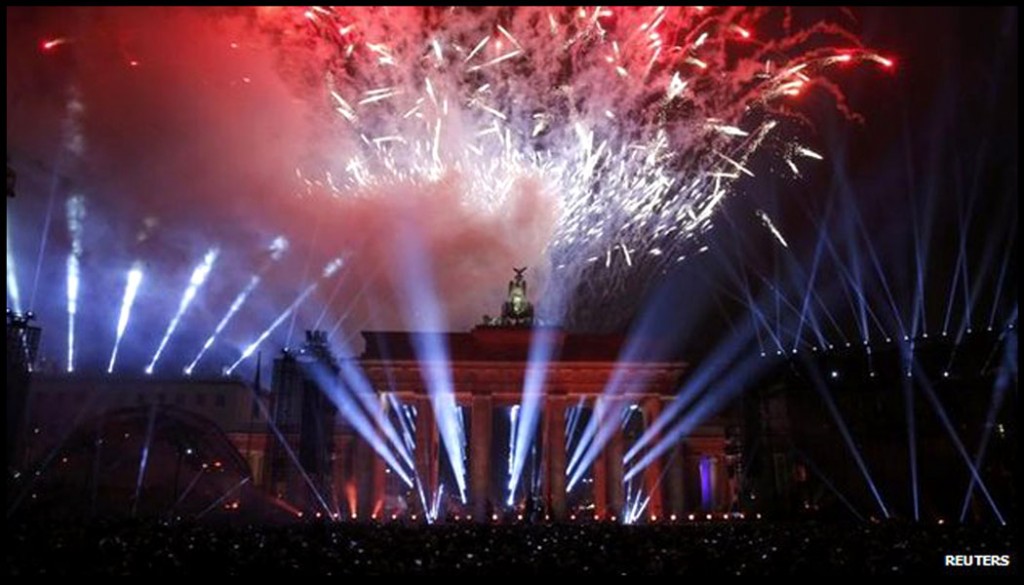 Fireworks over Brandenburg Gate followed the release of the balloons
Fireworks over Brandenburg Gate followed the release of the balloons
‘We can change things’
The day’s events began with a brass band playing, evoking the trumpets which brought down the walls of the biblical city of Jericho.
Chancellor Merkel, who grew up in East Germany, and other officials laid roses in one of the remaining sections of the wall.
Chancellor Merkel said it was easy to forget what had happened in Berlin
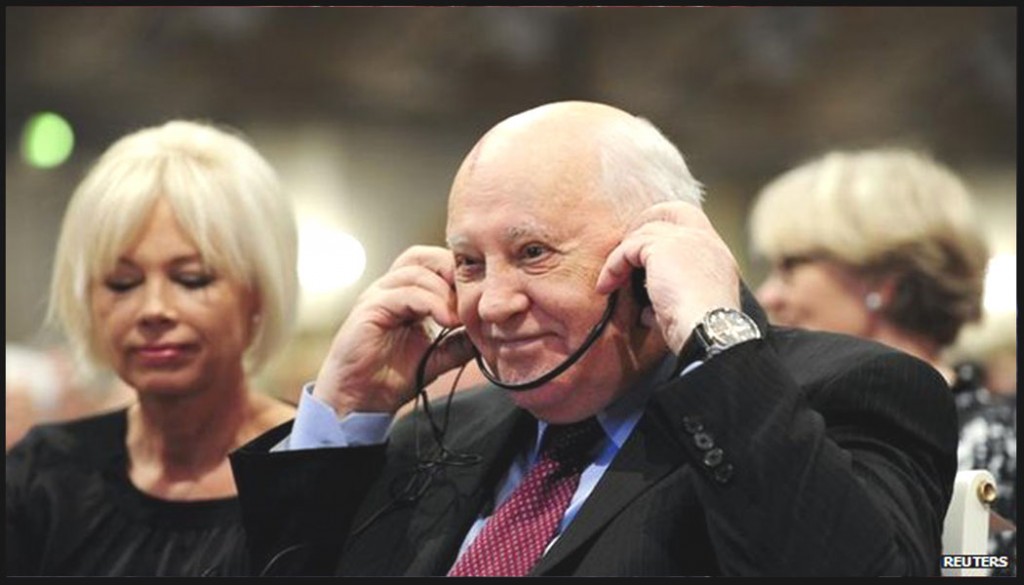 Former Soviet leader Mikhail Gorbachev attends a ceremony in Berlin
Former Soviet leader Mikhail Gorbachev attends a ceremony in Berlin
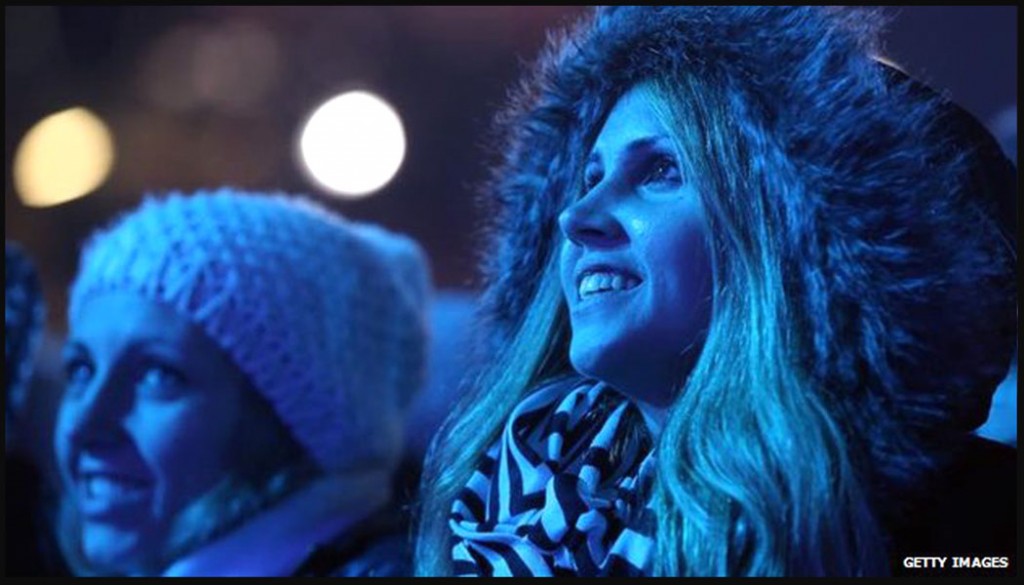 Tens of thousands joined the festivities in the German capital
Tens of thousands joined the festivities in the German capital
 Peter Gabriel performs at the Brandenburg Gate party
Peter Gabriel performs at the Brandenburg Gate party
Speaking at the opening of a new information centre about the Wall, Mrs Merkel said it was easy to forget what had happened and it was important to remember it.
“We can change things for the better,” she said. “This is the message for… Ukraine, Iraq and other places where human rights are threatened.
“The fall of the Wall showed us that dreams can come true. Nothing has to stay as it is.”
Recently Ms Merkel has revealed more details about her movements on the day that the Wall opened.
She told German TV on Saturday that she joined crowds heading towards West Berlin after a visit to the sauna, describing “an incredible feeling of happiness”.
The chancellor was joined later at the Brandenburg Gate by former Polish trade union leader and president Lech Walesa and Mikhail Gorbachev, the last Soviet leader.
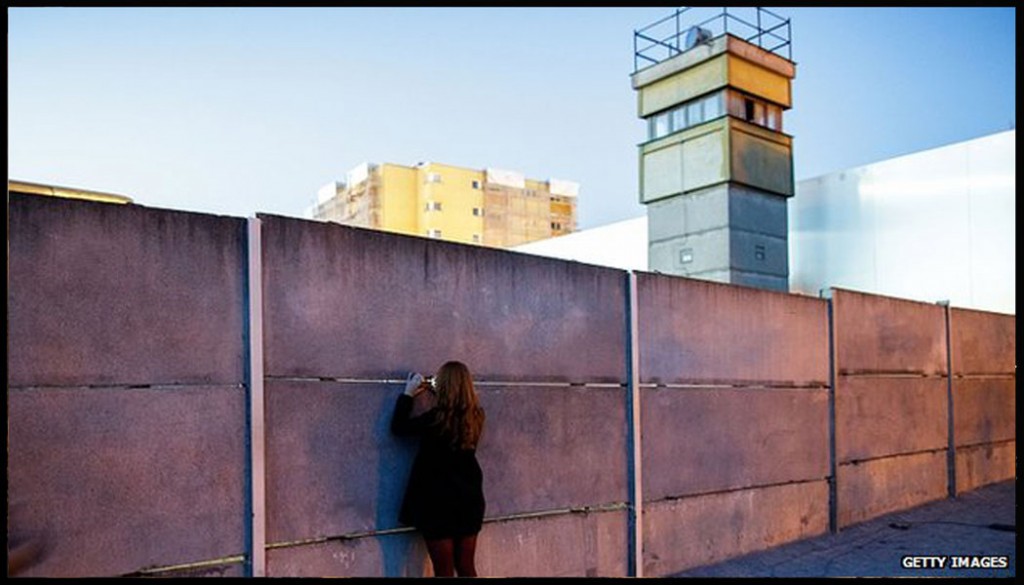 A guard tower still marks the “death strip” between layers of the former wall that divided Berlin
A guard tower still marks the “death strip” between layers of the former wall that divided Berlin
The first Trabant to cross from the East to the West 25 years ago, traverses the border again in commemoration – at the Ullitz crossing from Saxony into Bavaria
The wall stretched for 155km (96 miles) through Berlin but today only about three kilometres of it still stands.
At least 138 people died trying to flee to West Berlin.
Within a year of the wall’s collapse, Germany – divided after its defeat in World War Two – was reunited.
Striking a sombre note, Mr Gorbachev, 83, warned on Saturday that the world was on the brink of a new Cold War.
BBC2-11.9.2014
Germany marks anniversary of fall of Berlin Wall
https://www.bbc.com/news/world-europe-29974950
9 November 2014 Last updated at 05:02 ET
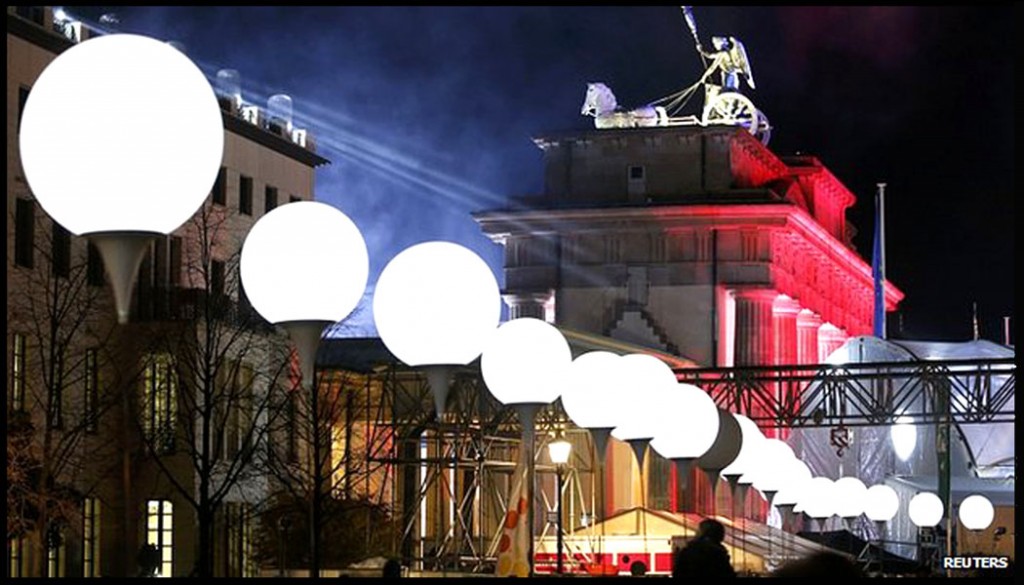 Illuminated white balloons, seen here near the Brandenburg Gate, mark the route of the Berlin Wall
Illuminated white balloons, seen here near the Brandenburg Gate, mark the route of the Berlin Wall
Celebrations are being held in Germany to mark the 25th anniversary of the fall of the Berlin Wall.
Chancellor Angela Merkel attended a service for victims of the communist East German regime, and will go to a huge party at the Brandenburg Gate.
White balloons marking a stretch of the wall will be released to symbolise its disappearance.
The Berlin Wall was built in 1961 to stop people fleeing from East Germany to the West.
Its fall in 1989 became a powerful symbol of the end of the Cold War.
The day’s events began with a brass band playing, evoking the trumpets which brought down the walls of the biblical city of Jericho.
Chancellor Merkel and other officials laid roses in one of the remaining sections of the wall.
While chatting to crowds afterwards, she said it was important to think about all those who suffered because of the Wall, not only in Germany but throughout Eastern Europe.
Ms Merkel, who grew up in East Germany, will be joined later by former Polish trade union leader and president Lech Walesa and Mikhail Gorbachev, the last Soviet leader.
The wall stretched for 155km (96 miles) through Berlin but today only about three kilometres of it still stands.
Within a year of its collapse, Germany – divided after its defeat in World War Two – was reunited.
Crowds have flocked to the remaining stretches of the Berlin Wall
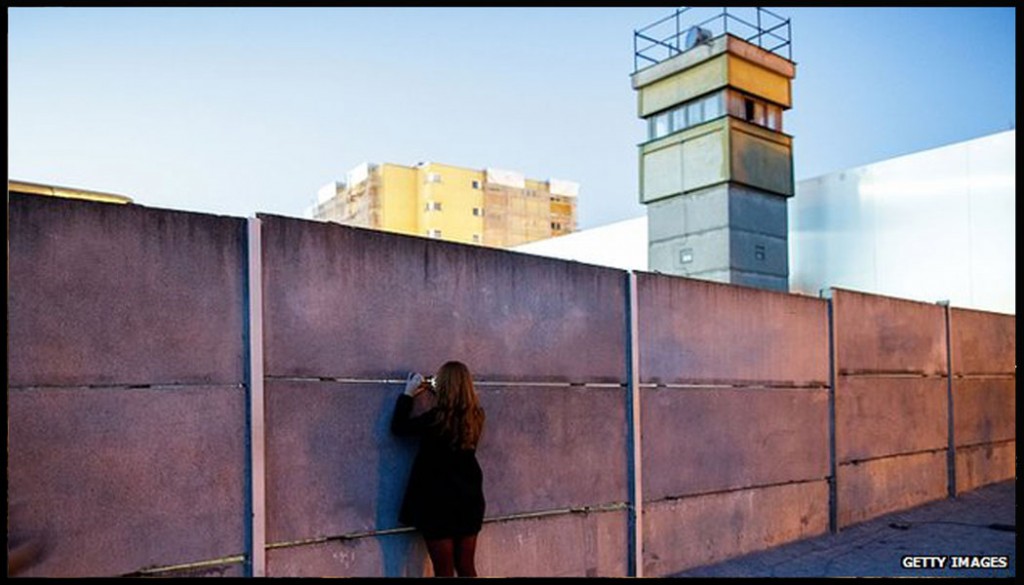 A guard tower still marks the “death strip” between layers of the former wall that divided Berlin
A guard tower still marks the “death strip” between layers of the former wall that divided Berlin
More than a million visitors have descended on Berlin for the weekend of festivities that will culminate later on Sunday at the Brandenburg Gate.
The monument itself was inaccessible during the partition of Germany and is seen as a symbol of the country’s reunification.
On Saturday, people posed for photos in front of the few remaining graffiti-daubed slabs of the wall, or read information boards about life under Berlin’s 28-year division.
Others admired the art installation of almost 7,000 white balloons, pegged to the ground and winding along a 15km (nine miles) stretch of the wall’s route.
At the bustling Potsdamer Platz, which was once cut in two by the wall, a small crowd watched archive footage of East German demonstrators chanting: “We are the people.”
Striking a more sombre note, Mr Gorbachev, 83, warned on Saturday that the world was on the brink of a new Cold War.
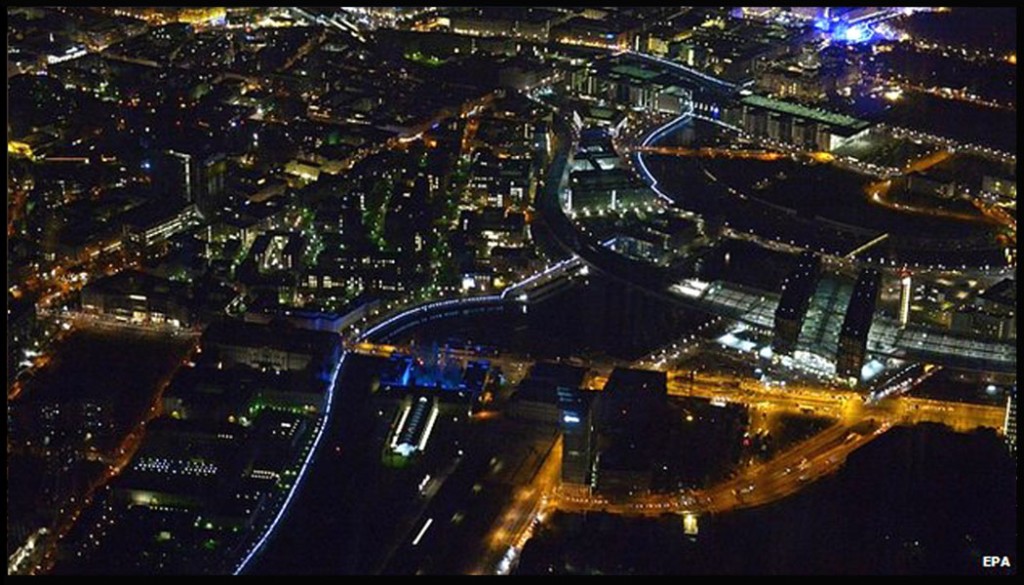 The route of the Berlin Wall is picked out by the illuminated balloons
The route of the Berlin Wall is picked out by the illuminated balloons
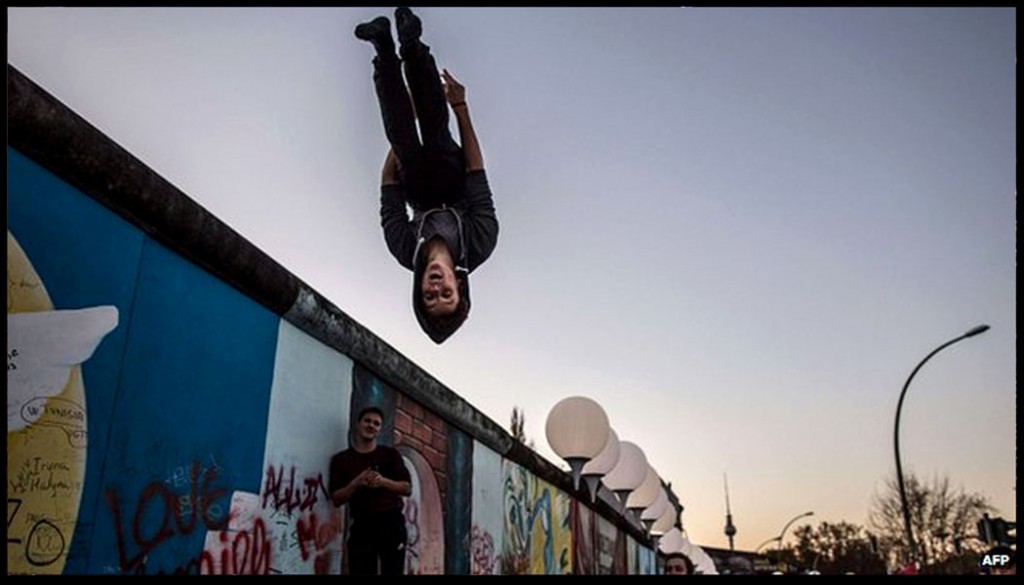 Entertainers have been rehearsing close to remaining stretches of the wall
Entertainers have been rehearsing close to remaining stretches of the wall
Tensions between the West and Russia have been raised by the crisis in Ukraine, which was part of the Soviet Union.
“Bloodshed in Europe and the Middle East against the backdrop of a breakdown in dialogue between the major powers is of enormous concern,” he said.
“The world is on the brink of a new Cold War. Some are even saying that it’s already begun.”
Mr Gorbachev said that the West – in particular the US – had succumbed to “triumphalism” after the collapse of the USSR in 1991.
For this reason the global powers had been unable to cope with conflicts in Yugoslavia, the Middle East and now Ukraine, he added.
Mr Gorbachev, as leader of the USSR in the late 1980s, is credited with rapprochement with the West and creating a more liberal atmosphere which led to the collapse of communist regimes in Eastern Europe in 1989.
BBC News on 11.8.2014
Ex-USSR leader Gorbachev: World on brink of new Cold War
Former Soviet President Mikhail Gorbachev “The world is on the brink of a new Cold War”
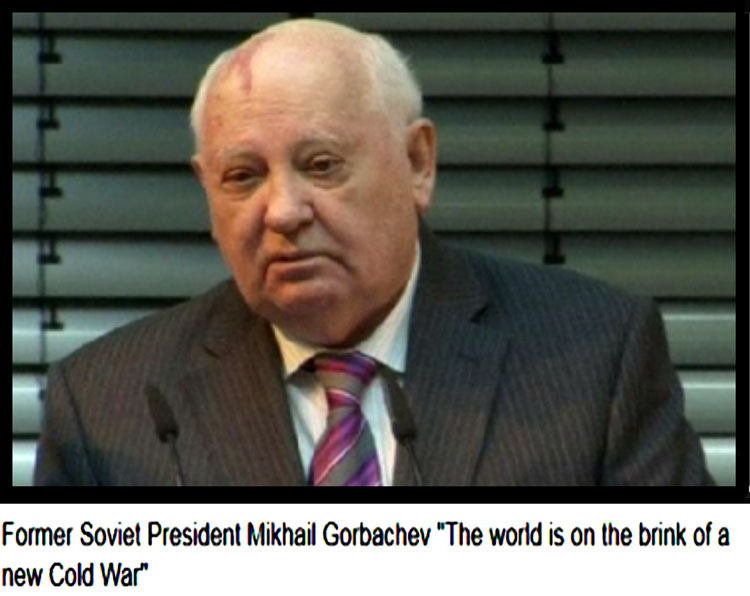 The world is on the brink of a new Cold War, and trust should be restored by dialogue with Russia, former Soviet leader Mikhail Gorbachev has said.
The world is on the brink of a new Cold War, and trust should be restored by dialogue with Russia, former Soviet leader Mikhail Gorbachev has said.
At an event to mark the 25th anniversary of the fall of the Berlin Wall on Sunday, Mr Gorbachev said the West had “succumbed to triumphalism”.
He expressed alarm about recent Middle Eastern and European conflicts.
Tensions have been raised between the West and Russia over Ukraine, which was part of the Soviet Union.
More than 4,000 people have died in fighting between Ukrainian forces and pro-Russian separatists, who seized control in the eastern regions of Donetsk and Luhansk in April.
A fragile ceasefire has been in place since September, but elections in rebel-held elections last weekend have prompted fears of a return to full-scale conflict.
Analysis: BBC’s Damien McGuinness in Berlin
Mikhail Gorbachev’s speech near the Brandenburg Gate shows that the 25th anniversary of the fall of the Berlin Wall is more than a way of remembering an historical event – but rather, given the Ukraine conflict, the events of 1989 have immediate relevance today.
The fall of the Wall is seen as the end of the Cold War – but according to Mr Gorbachev the world is on the brink of a new Cold War.
Many of his comments today will be seen as a commendable effort to de-escalate tensions – such as his calls for more dialogue.
But some of Mr Gorbachev’s other opinions are controversial in the West. He said Europe and the US were partly to blame for the conflict in Ukraine, citing Nato’s expansion into Eastern Europe.
And he accused Western leaders of triumphalism after 1989, saying they took advantage of Russia’s weakness.
Mr Gorbachev, 83, was attending an event at Berlin’s Brandenburg Gate.
The landmark was inaccessible during the Partition of Germany, and is seen as a symbol of the country’s reunification.
“Bloodshed in Europe and the Middle East against the backdrop of a breakdown in dialogue between the major powers is of enormous concern,” he said.
“The world is on the brink of a new Cold War. Some are even saying that it’s already begun.”
He said that the West, in particular the US, had succumbed to “triumphalism” after the collapse of the USSR in 1991.
For this reason the global powers had been unable to cope with conflicts in Yugoslavia, the Middle East and now Ukraine, he added.
 The Wall’s fall is a powerful symbol of the 1989 revolutions in Eastern Europe
The Wall’s fall is a powerful symbol of the 1989 revolutions in Eastern Europe
 White balloons follow the course of the Wall as part of the anniversary celebrations
White balloons follow the course of the Wall as part of the anniversary celebrations
The former Soviet leader urged the West to lift sanctions on Russian officials – imposed over the annexation of Crimea and Moscow’s alleged involvement in the Ukraine conflict – and restore trust through dialogue with the Kremlin.
Mr Gorbachev, as leader of the USSR in the late 1980s, is credited with rapprochement with the West and creating a more liberal atmosphere which led to the collapse of communist regimes in Eastern Europe in 1989.
On 9 November of that year East Germany opened its borders including the Wall, which separated East and West Berlin.
Its collapse led to a mood of euphoria, as many East Germans got their first glimpses of the West.
Hundreds are now arriving in the German capital to celebrate Sunday’s anniversary.
Festivities will include a rock concert and fireworks at the Brandenburg Gate. Other participants include German Chancellor Angela Merkel and former Polish president Lech Walesa.
Please visit the following links for more information:
https://www.bbc.com/news/world-europe-29966852
Berlin buzzing despite German slowdown Listen
The Guardian on 11.9.2014
A city undivided: the fall of the Berlin Wall commemorated 25 years on
Germans recall the ‘sheer madness’ of the night in 1989 when thousands of East Berliners streamed across the border
https://www.theguardian.com/world/2014/nov/09/berlin-wall-fall-remembered-residents-25-anniversary
Berlin Wall – readers’ memories: ‘It’s hard to remember how scary the Wall was’
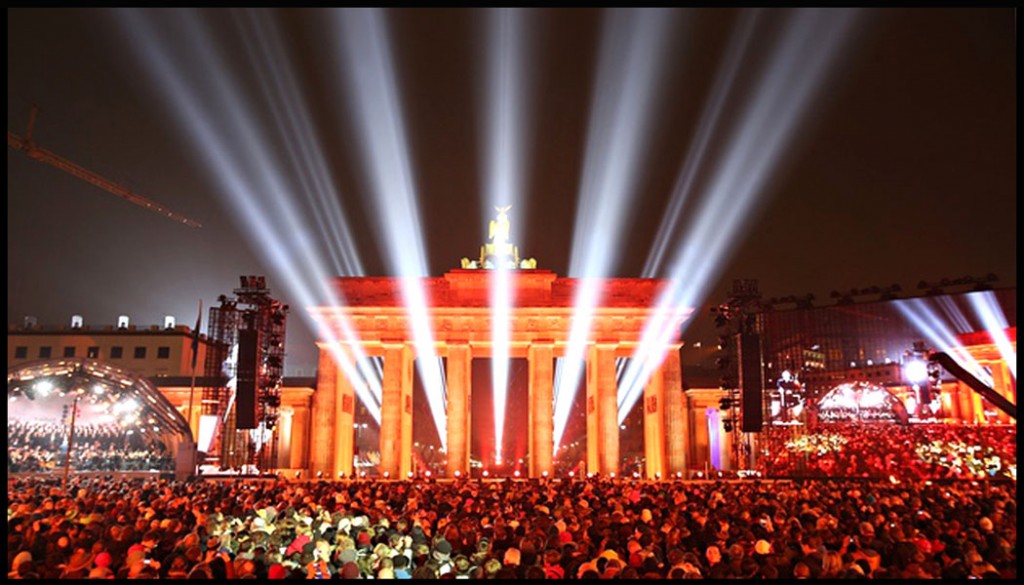 The Brandenburg Gate stands illuminated during celebrations on the 25th anniversary of the fall of the Berlin Wall. Photograph: Sean Gallup/Getty Images
The Brandenburg Gate stands illuminated during celebrations on the 25th anniversary of the fall of the Berlin Wall. Photograph: Sean Gallup/Getty Images
Philip Oltermann in Berlin
Sunday 9 November 2014 15.56 EST
As the long row of helium-filled white balloons lifted off one by one into the night sky over Berlin, Tina Krone managed to gulp down a tear and lit a sparkler. “I haven’t seen that many people on the streets for 25 years,” she said, surveying the crowds at Bernauer Strasse.
On 9 November 1989, when she and thousands of other East Berliners streamed across the border into the west shortly before midnight, only those old enough to remember the building of the wall had cried.
Krone and her friends, on the other hand, had simply been lost for words: “‘Madness, sheer madness’. I know it’s not very original of me, but I must have said that a thousand times that night.”
An active member of the East German dissident movement, she had received a call from a friend in the west at about 10.30pm: “Have you seen the news? They’re saying the wall is open.”
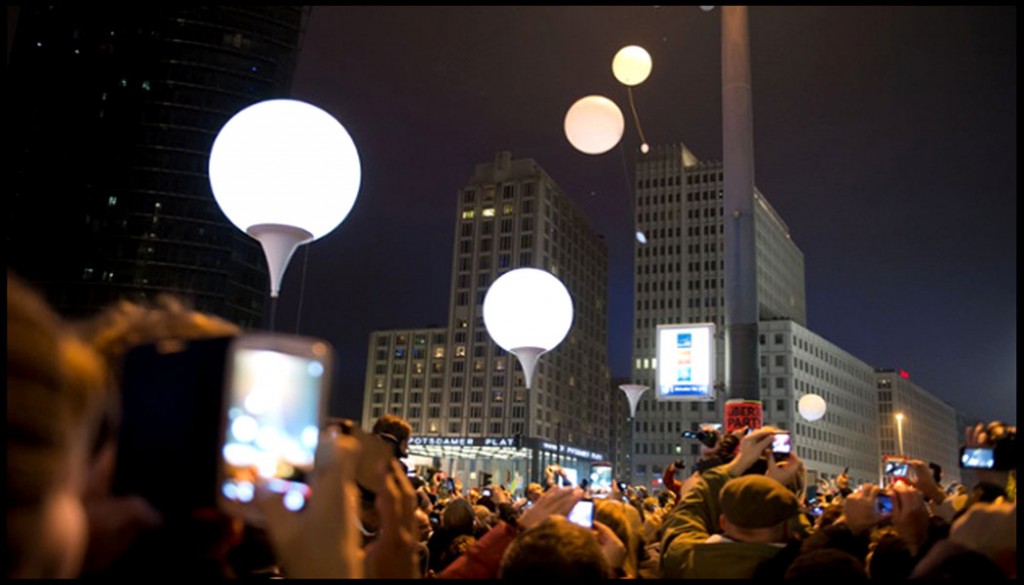 Illuminated balloons, part of the so-called Border of Light, rise into the sky at the Potsdamer Platz in Berlin. Photograph: Soeren Stache/Corbis
Illuminated balloons, part of the so-called Border of Light, rise into the sky at the Potsdamer Platz in Berlin. Photograph: Soeren Stache/Corbis
Because the closest border crossing to her at Bornholmer Strasse was already crowded, she and her partner jumped into their Trabant car to head to Kreuzberg.
When she had passed through the checkpoint at Heinrich Heine Strasse, a West Berliner thrust a bottle of beer into her hand, but she says she did not need to take a single sip to feel intoxicated.
In a bar, she and her partner met long-lost friends, who gave them a pile of western newspapers and a small colour TV as a welcoming gift. By daybreak, they were back at the checkpoint – there had been rumours that the border would close again at 8am.
Only when the guards waved them through for a second time did the reality sink in. “Then I knew there was no way back for the party bigwigs,” Krone says. “After that, it felt like our Trabi was flying us home.”
Whatever one’s views of the handling of the aftermath of the wall’s fall, memories of 9 November 1989 still have power. And while fall-of-the-wall anniversaries come and go, this year’s art installation, conceived by brothers Christopher and Marc Bauder, managed to create a rare thing: a memorial that felt both poignant and playful, thought-provoking but not maudlin.
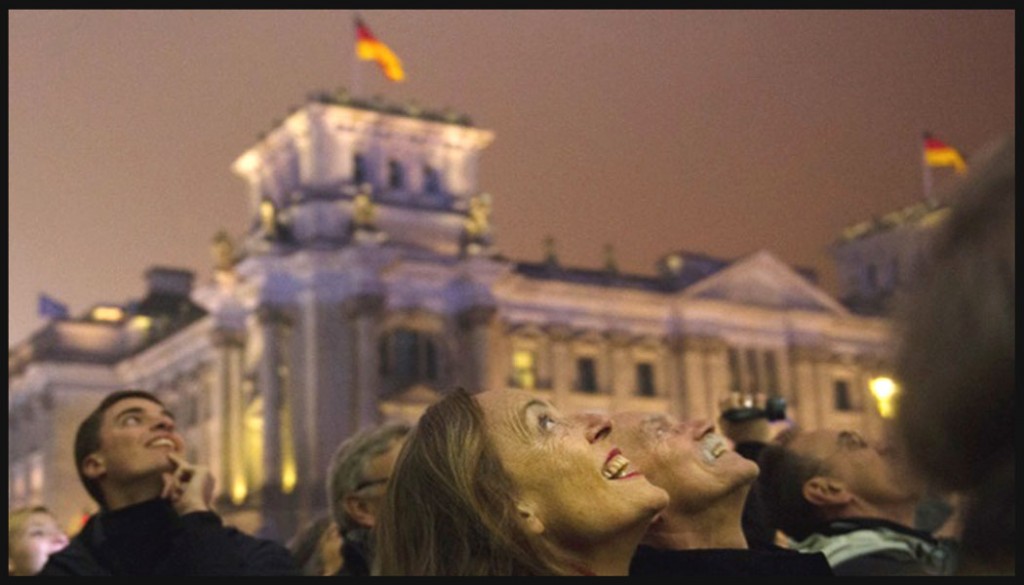 People watch balloons marking the former border flying away in front of the Reichstag building. Photograph: Steffi Loos/AP
People watch balloons marking the former border flying away in front of the Reichstag building. Photograph: Steffi Loos/AP
Since Friday morning, a so-called Lichtgrenze or “border of light”, made up of 8,000 balloons, has traced a section of the fallen wall across central Berlin for 15km (nine miles).
On Friday and Saturday night, thousands of Berliners old and young were out on the streets to walk along the old border.
Those who grew up in a divided Berlin are unlikely to ever forget the precise route of the old dividing line.
Krone says she still feels a bit queasy when she passes from east to west and recalls that it “hurt” the first time she passed under the Brandenburg Gate. The driver of the taxi in which she was travelling turned around and did it again, three times in total, “until it stopped hurting”.
But for tourists, it is surprisingly hard to tell these days where West Berlin used to start and East Berlin used to end. On Potsdamer Platz and near the central station, the area where the wall of light ran this weekend has been wholly renovated and is unrecognisable from the wasteland of 1989. In the hipper parts of Kreuzberg, the installation has reminded more recent arrivals that a country used to end right outside their doorstep.
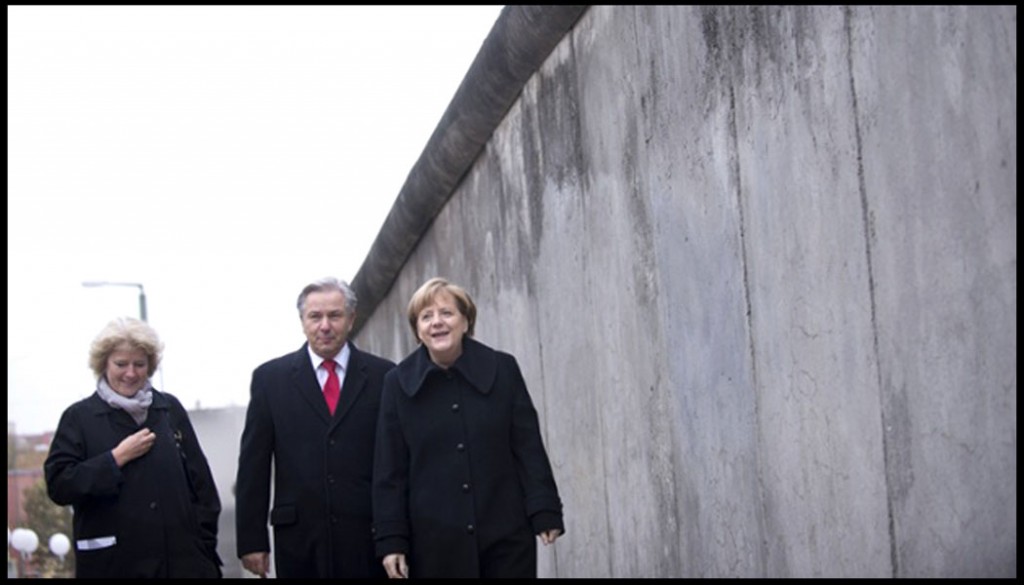 German chancellor Angela Merkel walks along a section of the former Berlin Wall during celebrations for the 25th anniversary of its fall. Photograph: Imago / Barcroft Media
German chancellor Angela Merkel walks along a section of the former Berlin Wall during celebrations for the 25th anniversary of its fall. Photograph: Imago / Barcroft Media
At 7.20pm, with a considerable delay, the first balloon floated into the night sky in front of the Brandenburg Gate. The Berlin State Orchestra played Beethoven’s stirring Ninth Symphony and outgoing Berlin mayor, Klaus Wowereit, gave a short speech. “Walls made of concrete and walls in our heads are surmountable when people come together and take their fate into their own hands,” he said.
At Bernauer Strasse, the row of balloons took a sharp left into Mauerpark, once a section of the death strip, now a giant park for residents. Some people had climbed on to the strip of wall in front of the Friedrich-Ludwig-Jahn sports stadium to get a better view, as if in tribute to the pictures that were transmitted around the world in 1989.
Back then it was here, in the Prenzlauer Berg district, that the power of crowds forced the first border point to open. On Sunday, the locals’ famed impatience was once again on display: a number let go of their balloons early.
This year’s commemoration of the fall of the Iron Curtain may also feel more poignant because there is a palpable sense that peace in Europe in 2014 is more fragile than it was at the 20th anniversary in 2009.
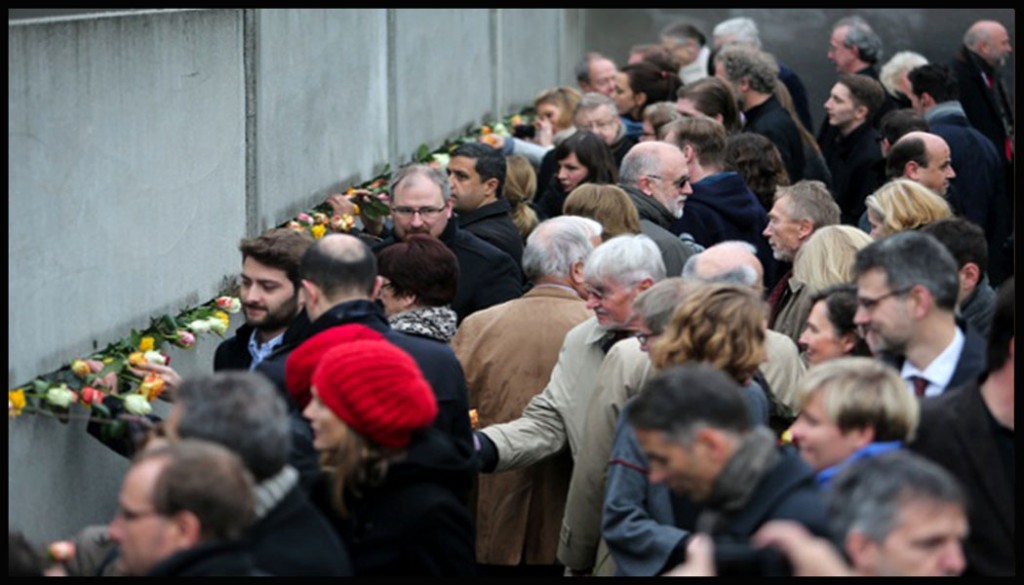 People attend a memorial activity to commemorate the 25th anniversary of the fall of the Berlin Wall. Photograph: Xinhua/Landov/Barcroft Media
People attend a memorial activity to commemorate the 25th anniversary of the fall of the Berlin Wall. Photograph: Xinhua/Landov/Barcroft Media
In her speech at the wall memorial on Bernauer Strasse on Saturday afternoon, Germany’s chancellor, Angela Merkel, had explicitly emphasised the geopolitical resonances of the event, instead of indulging in personal reminiscences.
“We have the strength to shape things, to turn things from bad to good, that is the message of the fall of the wall,” she said. “These days, that message is directed at Ukraine, Syria, Iraq and many, many other regions in the world.”
Merkel, who on 9 November 1989 had walked over into the west at the Bornholmer Strasse checkpoint on her way back from the sauna, with her wet towel still in her bag, said: “If one thing was wonderful about those days, it was the imagination that was being set free after having been suppressed for so many years.”
Jean-Claude Juncker, the president of the European commission, issued a statement on the anniversary, warning that “Europe must once again become a thing of the heart”. He said: “It was with passion and courage that the people tore down that which divided them, in search of peace, freedom, unity, democracy and prosperity. Two decades later, we must not forget that peace is not a given in Europe. More than ever, Europe must live up to its responsibility to safeguard freedom and peace.”
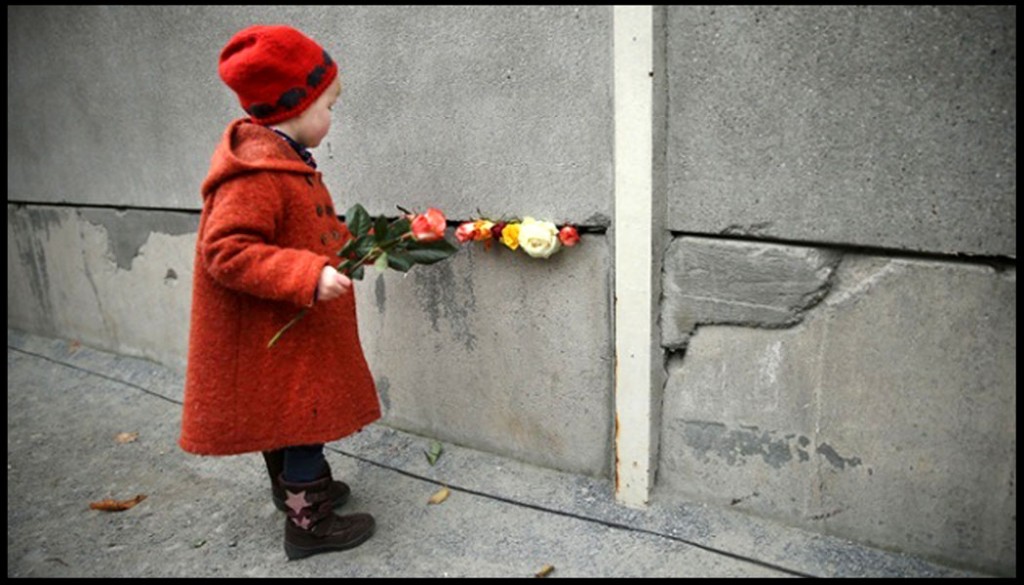 Hulda, 3, places flowers in between slats of the former Berlin Wall at the Berlin Wall Memorial at Bernauer Strasse. Photograph: Sean Gallup/Getty Images
Hulda, 3, places flowers in between slats of the former Berlin Wall at the Berlin Wall Memorial at Bernauer Strasse. Photograph: Sean Gallup/Getty Images
On Saturday, the former Russian president Mikhail Gorbachev warned of a “new cold war”, brought about by the west’s mishandling of the aftermath of the fall of the wall.
“Instead of building new mechanisms and institutions of European security and pursuing a major demilitarisation of European politics … the west, and particularly the United States, declared victory in the cold war,” said the man behind the Soviet Union’s glasnost and perestroika reforms, speaking at a symposium near the Brandenburg Gate.
“Euphoria and triumphalism went to the heads of western leaders. Taking advantage of Russia’s weakening and the lack of a counterweight, they claimed monopoly leadership and domination in the world.”
The enlargement of Nato, Kosovo, missile defence plans and wars in the Middle East had led to a “collapse of trust”, said Gorbachev, now 83. “To put it metaphorically, a blister has now turned into a bloody, festering wound.”
Please visit the following links for more information:
BBC News on 11.4.2014
Berlin leaves divisions behind as Wall’s traces vanish
https://www.bbc.co.uk/search?q=25%20aniversary%20Berlin%20Wall%20fall%20Pictures
https://www.bbc.com/news/world-middle-east-29829336
4 November 2014 Last updated at 19:58 ET
By Moritz Schuller Tagesspiegel newspaper, Berlin
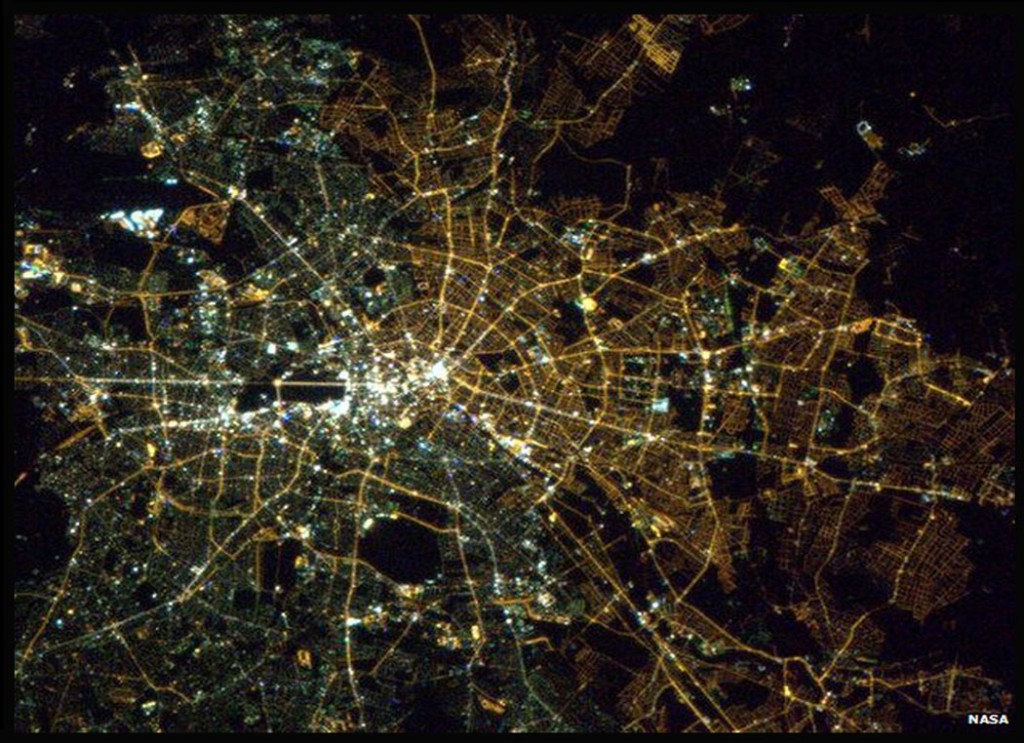 Chris Hadfield’s picture from space clearly shows the yellower lighting in East Berlin
Chris Hadfield’s picture from space clearly shows the yellower lighting in East Berlin
A year ago the Canadian astronaut Chris Hadfield sent down from space an image that was both beautiful and astonishing.
His picture of Berlin, taken from hundreds of miles above the Earth, was that of a city divided.
The West glowed in a whitish colour, the East was yellowish – and the dividing line looked suspiciously like that of the infamous wall which had once cut the city in two.
A divided Berlin? Twenty-five years after the wall came crushing down to mark one of the happiest days in the city’s history?
From less than 200 miles above the Earth that dividing line is hardly visible.
In fact, Berlin has done away with the wall so thoroughly that those wanting to mark the anniversary needed to rebuild the monument. It doesn’t run through a barbed wire death strip any more but a huge mall on Potsdamer Platz.
Today, the guard tower overlooks H&M and a lingerie boutique.
An original East German guard tower near Potsdamer Platz is now a tourist attraction
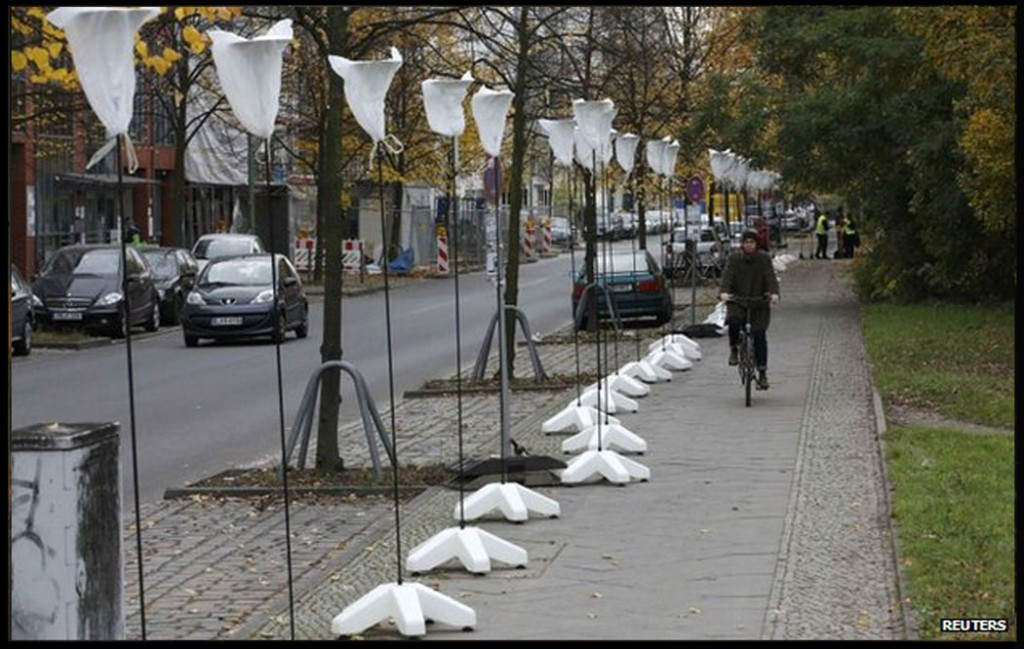 Part of Berlin is being temporarily divided to commemorate the 25th anniversary of the fall of the Berlin Wall
Part of Berlin is being temporarily divided to commemorate the 25th anniversary of the fall of the Berlin Wall
And yet, Commander Hadfield’s picture from outer space speaks some truth.
Angela Merkel, a former East Berliner, may today be running the country, but the street lamps in the East are still sodium-vapour lamps with a yellower colour and the ones in the West are still fluorescent lamps with a whiter colour.
In the East people still read Berliner Zeitung, while the West reads Tagesspiegel.
One half roots for Hertha BSC, the other for FC Union, the football team from the East.
The income gap is closing, but it is still exists. In those exciting weeks 25 years ago, West Berliners went rural, East Berliners went commercial.
One half longed for a countryside from which they had been cut off for 30 years and the others for a more urban, less drab environment. Soon, they returned to their old neighbourhoods and their old ways of life.
Berlin, perhaps because it has seen and suffered so much, is a complacent city.
The East Berliners approached unification perhaps with a more pride than the rest of their country.
 Bernauer street on 10 November 1989 (L) as crowds push through the wall and (R) the same street today
Bernauer street on 10 November 1989 (L) as crowds push through the wall and (R) the same street today
East Berlin had been the country’s capital, and it is still home to a multitude of Communist Party and Stasi cadres, the last stalwarts of the old system.
Just like West Berlin, it was a highly subsidised social entity – both parts were propped up as showcases of their respective political systems.
This fed into a sense of importance on both sides of the wall, even before it collapsed, which their West and East German compatriots found at once off-putting and attractive.
The union worked because Berlin, traditionally a working-class city, was able to deal well with the remnants of the East German establishment and the post-communists’ election successes in the 1990s.
No wonder, then, that it was Berlin where one of the first coalition governments involving the post-communists was formed.
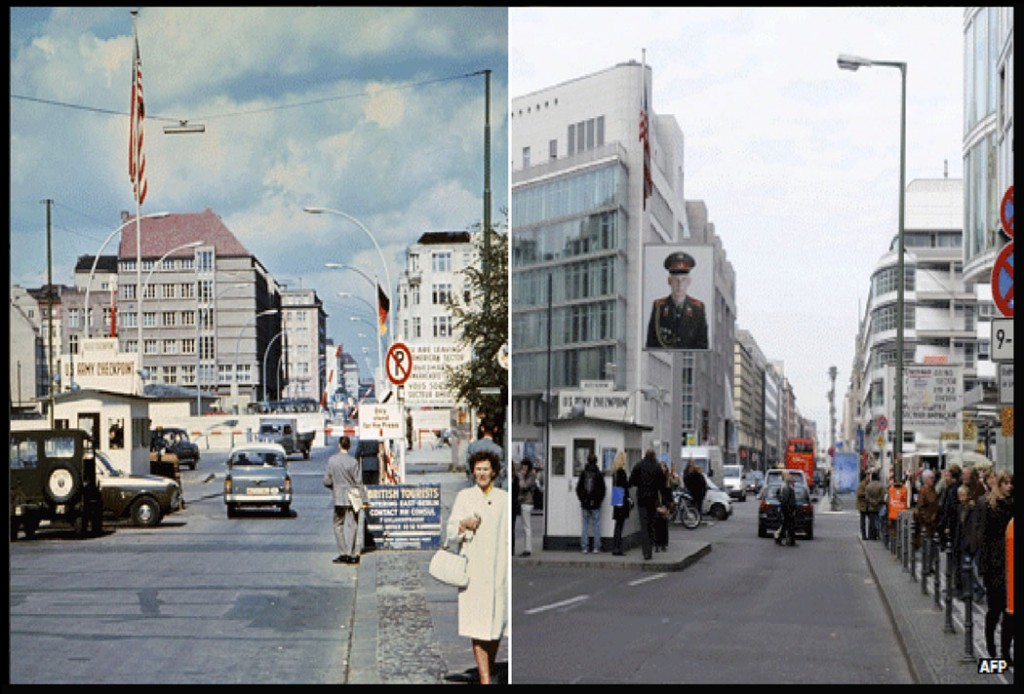 Checkpoint Charlie (L in 1968) marked the border between the Soviet and American sectors and (R) in 2009
Checkpoint Charlie (L in 1968) marked the border between the Soviet and American sectors and (R) in 2009
West Berlin, for many years an island in the sea of socialism, had always lacked Munich’s or Hamburg’s bourgeois elites. And even today the unified Berlin retains more of its East German legacy than most of the rest of the country.
At the same time, none of those who flocked to Berlin after 1989 were too worried about the city’s past.
The 20-year-olds from Stuttgart and Dublin, the EasyJetters, the DJs, the artists, the fly-by-night real estate cowboys, the start-up financiers, the unemployed academics from Spain, they didn’t concern themselves with the wall or the pain it had inflicted upon the city.
They brought a different and more innocent geography to the city.
To them the past, divided in East and West, was never more than the backdrop for their big party, fascinating but as unreal as The Third Man.
The throngs of young Israelis moving to Berlin and staging gay, “meshugge” (crazy) parties seem to indicate that Hitler’s old haunt has finally turned the page.
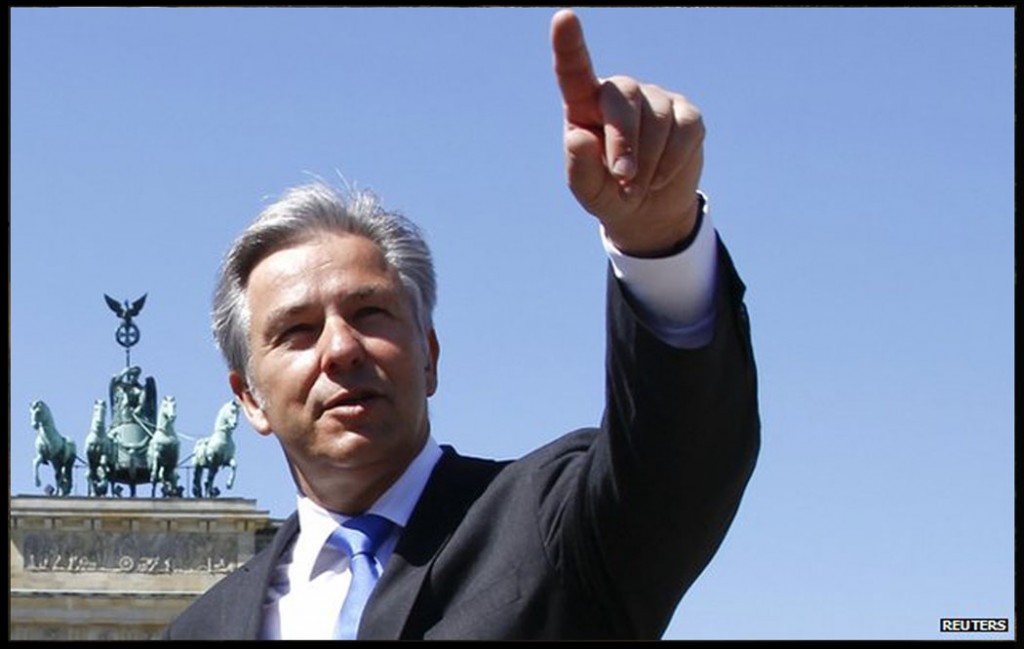 Berlin Mayor Klaus Wowereit coined the phrase “poor, but sexy” for Germany’s reunified capital
Berlin Mayor Klaus Wowereit coined the phrase “poor, but sexy” for Germany’s reunified capital
Eventually, the former East and West Berliners adopted that view of their city.
If everybody else is gushing about the exciting, unique new Berlin, why quibble with that? Why keep harping upon the past?
The newcomers allowed the locals to adopt a new narrative of their own city. And they did.
Berlin became a work in progress, hyped by its officials as the home of the future and brought down again by the uncouth Berliners themselves and their charming lack of ambition – to them a strip of lawn, a sausage and a beer amounts to an afternoon well spent.
Clearly that has a global appeal. Twenty-five years after the fall of the wall, Berlin is poor, but sexy, as outgoing Mayor Klaus Wowereit once said.
It is a provincial metropolis, a cultural playground, and this time it is being subsidised by those who are drawn to it and its allure.
Soon more time will have elapsed since the fall of the wall than the wall actually lasted. Yet, the social, cultural and political differences between East and West Berlin are still detectable.
They don’t matter so much, however, because the city has found a different urban narrative. And, also, they don’t matter so much, because Berlin has always been a city where differences mattered less than elsewhere.
Moritz Schuller is opinion page editor at Tagesspiegel in Berlin.
Berlin at a glance
- Population 3.5 million approx.
- Foreigners 372,300
- Unemployment 10.8%
- City reunified 9 November 1989
- German parliament moves from Bonn to Berlin 19 April 1999
German government moves to Berlin 26 June 1999
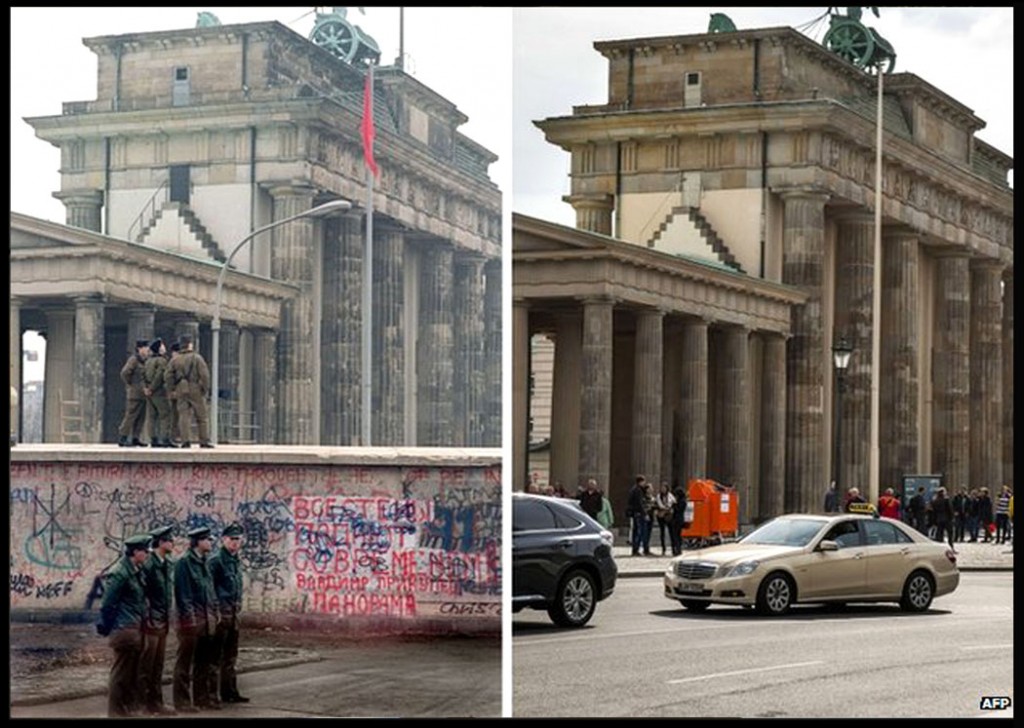 Berlin’s Brandenburg Gate in December 1989 (L) with East and West German policemen and (R) today
Berlin’s Brandenburg Gate in December 1989 (L) with East and West German policemen and (R) today
Please visit the following links for more information:
02 NOVEMBER 2014, EUROPE
30 OCTOBER 2014, EUROPE
14 OCTOBER 2014, MAGAZINE
22 MAY 2014, EUROPE
Around the BBC
Mauer-Museum am Checkpoint Charlie
CheckpointCharlieMuseum
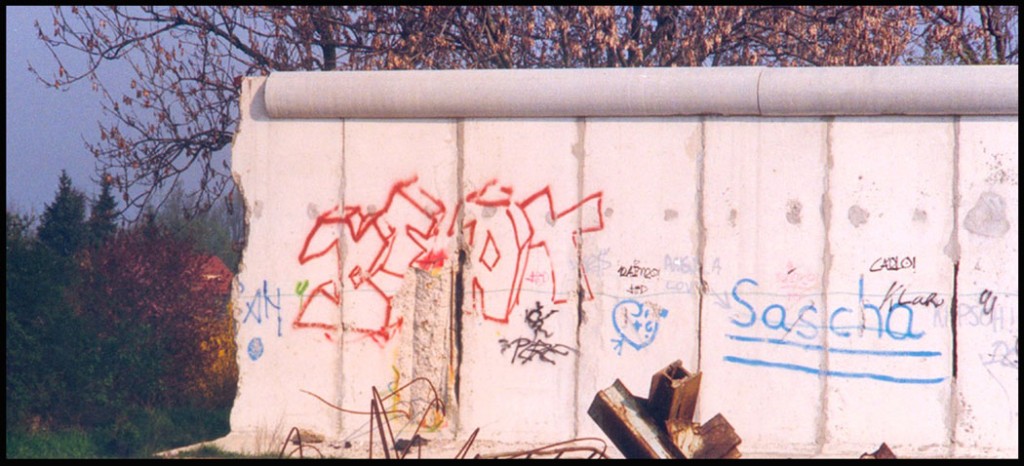 FACTS ABOUT THE BERLIN WALL (FROM JULY 1989)
FACTS ABOUT THE BERLIN WALL (FROM JULY 1989)
Total ring around Berlin: 155km
Length between West and East Berlin: 43.1km
Length between West Berlin and the GDR: 111.9km
Metal fencing: 66.5km
Observation Towers: 302
Bunkers: 20
Dog-runs: 259
Anti-vehicle trenches: 105.5km
Electric contact or signal fencing: 127.5km
Military roadway: 124.3km
Measurements for each wall segment:
Height: 3.6m
Width: 1.2m
Breadth at base: 2.1m
Weight: 2.6 tonnes
Material: Reinforced concrete
Germany Info/Vertretung/USA
Looking Back at the Fall of the Berlin Wall
https://www.germany.info/Vertretung/usa/en/02__GIC/GIC/05/08-Mauerfall25/02-Timeline/Timeline__S.html
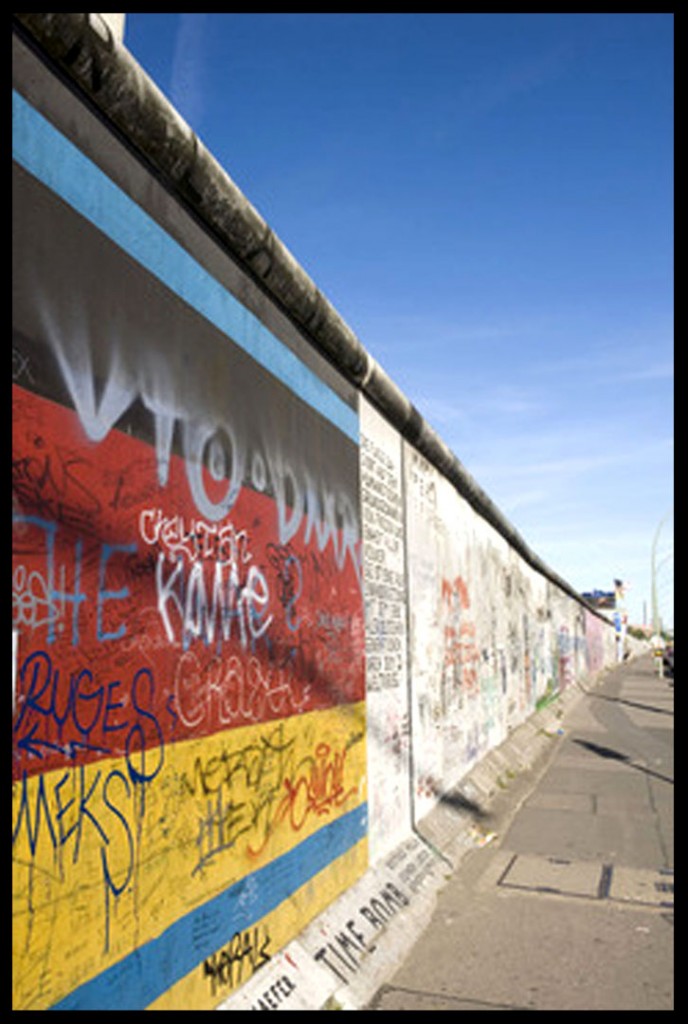 The Berlin Wall in 1990. (© picture-alliance/dpa) On November 9, 1989, the world watched in amazement as jubilant crowds gathered on both sides of the Berlin Wall around midnight to celebrate the opening of the border crossings between the eastern and western parts of the city. A peaceful revolution in East Germany had finally cracked this grim symbol of Cold War and political oppression. It signaled the beginning of the end of Germany’s postwar division and national unity came less than a year later on October 3, 1990.
The Berlin Wall in 1990. (© picture-alliance/dpa) On November 9, 1989, the world watched in amazement as jubilant crowds gathered on both sides of the Berlin Wall around midnight to celebrate the opening of the border crossings between the eastern and western parts of the city. A peaceful revolution in East Germany had finally cracked this grim symbol of Cold War and political oppression. It signaled the beginning of the end of Germany’s postwar division and national unity came less than a year later on October 3, 1990.
Erected on August 13, 1961 by the communist regime in East Germany, the Wall divided Berlin for 28 years. It cut right through the heart of the city, amputating vital traffic links and separating families and friends. Minefields and border police with shoot-to-kill orders thwarted any further attempts by East Germans to look for a better future in the West. While the communists tightened their grip on people’s lives in East Berlin, the western part of the city became a walled-in outpost of freedom and democracy.
Today, Berlin is once again Germany’s vibrant capital. The wounds of history have healed. Twenty years after the fall of the Berlin Wall, its vestiges remind us that freedom is precious. Freedom would not have prevailed and reunification would not have been achieved, in Berlin and in Germany as a whole, without the steadfast and unfaltering support of our American friends. We celebrate the 20th anniversary of the fall of the Berlin Wall in a spirit of deep gratitude and with a desire to share our experience – the vision of hope, of unity, and of Freedeom Without Walls.
US President John F. Kennedy gave his famous “Ich bin ein Berliner!” (I am a Berliner!) speech on June 26, 1963. (© picture-alliance/dpa)
BERLIN WALL TIMELINE
1945 – World War II ends: The Allied Powers split Germany into four occupation zones, and its capital Berlin into four sectors.
1949 – Cold War: The Federal Republic of Germany emerges out of the US, British and French zones in the West. The Soviet Union establishes the communist German Democratic Republic (GDR) in their eastern zone, but cannot push the three Western powers out of Berlin.
1950s: Economic success of West Germany, fueled by the US Marshall Plan, and increased political repression at home swell the numbers of East Germans looking for a better life in the West. The GDR seals off the inner German border, leaving Berlin as the last loophole to the West.
1961 – August 13: All crossing points between the East and West Berlin are closed by GDR forces. Construction of the Berlin Walls begins.
1961 – August 22: The Wall claims its first of several hundred victims, when Ida Siekman falls to her death while trying to escape to the West by jumping out of her appartment at Bernauer Strasse. The exact number of Wall victims remains unknown.
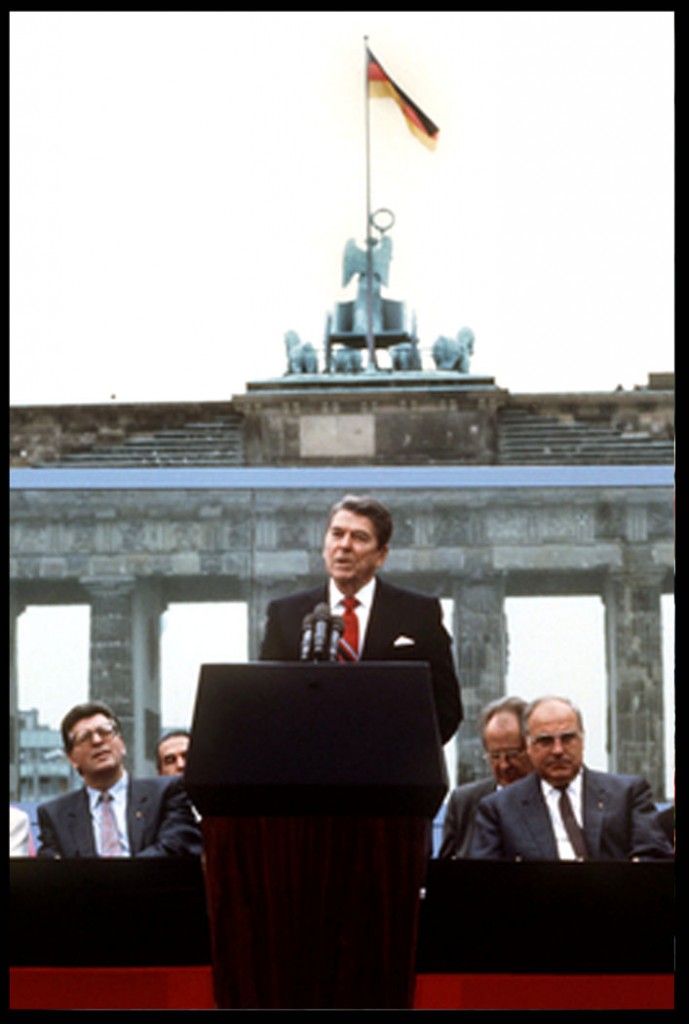 US President Ronald Reagan visited Berlin on its 750th anniversary in 1987, where he delivered a rousing speech. He is flanked by German Chancellor Helmut Kohl (r) and Bundestagspräsident Philipp Jenninger (l). (© picture-alliance/dpa) 1963 – June 26: President John F. Kennedy visits Berlin, reaffirming US support for this outpost of freedom with his famous “Ich bin ein Berliner!” (“I am a Berliner!”) speech.
US President Ronald Reagan visited Berlin on its 750th anniversary in 1987, where he delivered a rousing speech. He is flanked by German Chancellor Helmut Kohl (r) and Bundestagspräsident Philipp Jenninger (l). (© picture-alliance/dpa) 1963 – June 26: President John F. Kennedy visits Berlin, reaffirming US support for this outpost of freedom with his famous “Ich bin ein Berliner!” (“I am a Berliner!”) speech.
1987 – June 12: President Ronald Reagan delivers a speech in front of Berlin’s iconic Brandenburg Gate in which he memorably demands: “Mr. Gorbachev, tear down this wall!”
1989: Amidst increasing economic failure of the communist regime, the first protesters gather in Leipzig with calls for democratic reforms and individual rights. Their movement quickly spreads to all major cities in the GDR.
1989 – November 9: Unable to suppress this peaceful revolution and hoping to buy time, the GDR leadership lifts all previous travel restrictions to the West. Shortly before midnight, tens of thousands flock to the Berlin Wall. The border guards cannot hold them back. On the other side, jubilant crowds greet the first arrivals.
1990 – October 3: After the Wall fell, it was to be another 11 months before Germany was reunited. In the first (and last) free elections to East Germany’s Volkskammer (parliament) on March 18, 1990 the East German electorate voted by an overwhelming majority for those parties that demanded swift accession to West Germany. In summer 1990 a treaty to this effect was negotiated by the two Germanies. East Germany acceded to West Germany on October 3, 1990, which has since been celebrated as the Day of German Unity and is an official holiday in Germany.
VisitBerlin on 11.9.2014
https://www.visitberlin.de/en/event/11-09-2014/25-years-fall-of-the-berlin-wall
25 Years Fall of the Berlin Wall – an overview
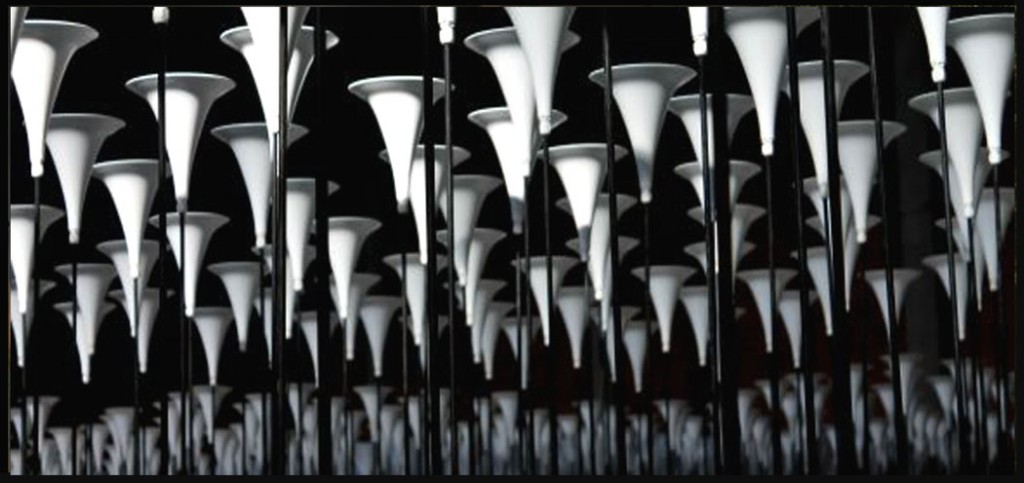 Preparing for the lights border wall anniversary event . Thousands balloon holders waiting for their construction along the former border. © Jan Frontzek
Preparing for the lights border wall anniversary event . Thousands balloon holders waiting for their construction along the former border. © Jan Frontzek
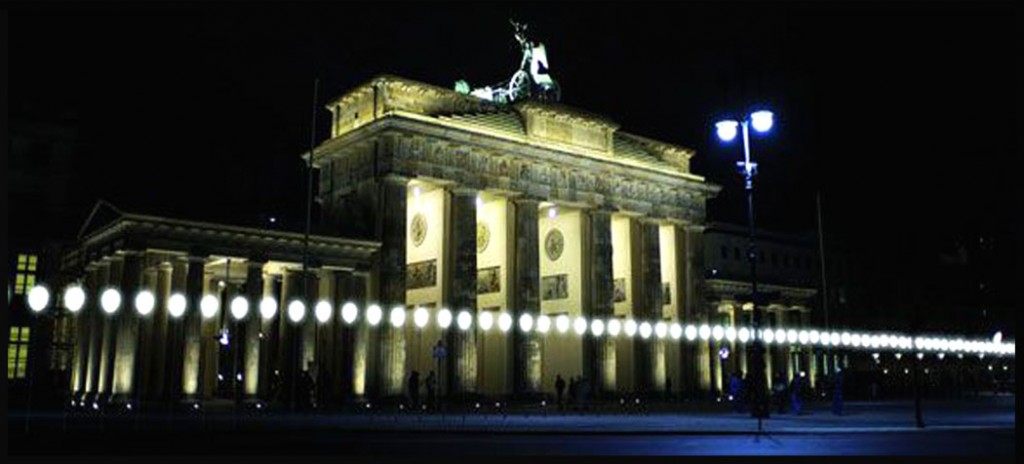 – © Kulturprojekte Berlin/Christopher Bauder
– © Kulturprojekte Berlin/Christopher Bauder
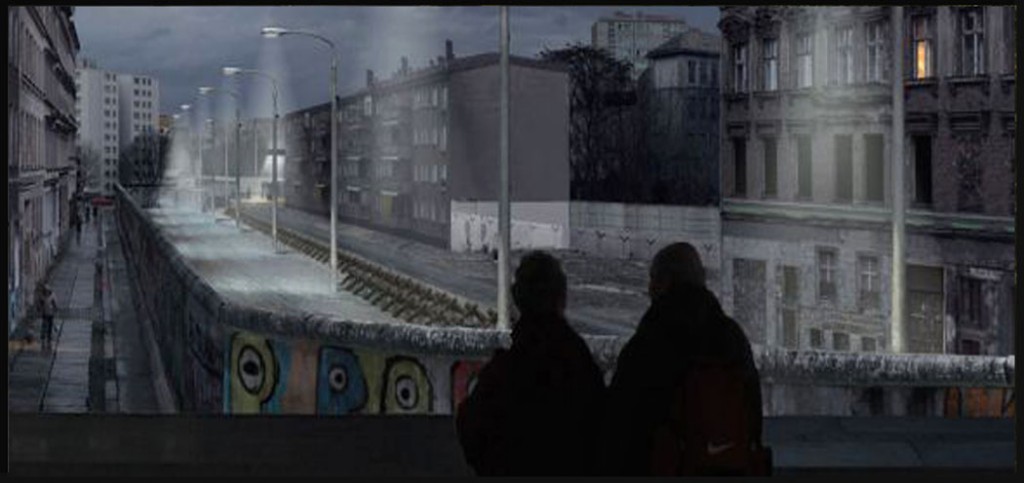 Visualization of ” THE WALL – The asisi panorama to a divided Berlin ,” View from the visitors platform , 2011 © asisi
Visualization of ” THE WALL – The asisi panorama to a divided Berlin ,” View from the visitors platform , 2011 © asisi
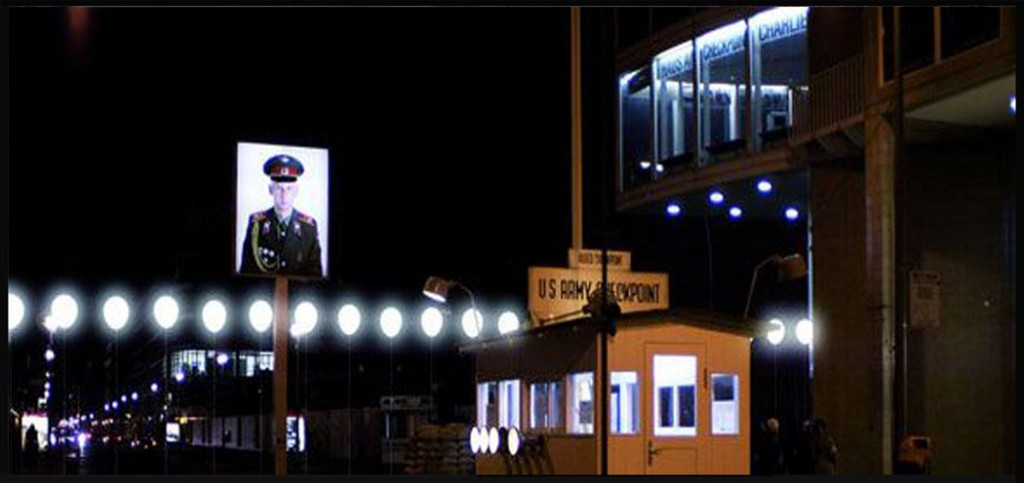 – © Kulturprojekte Berlin/Christopher Bauder
– © Kulturprojekte Berlin/Christopher Bauder
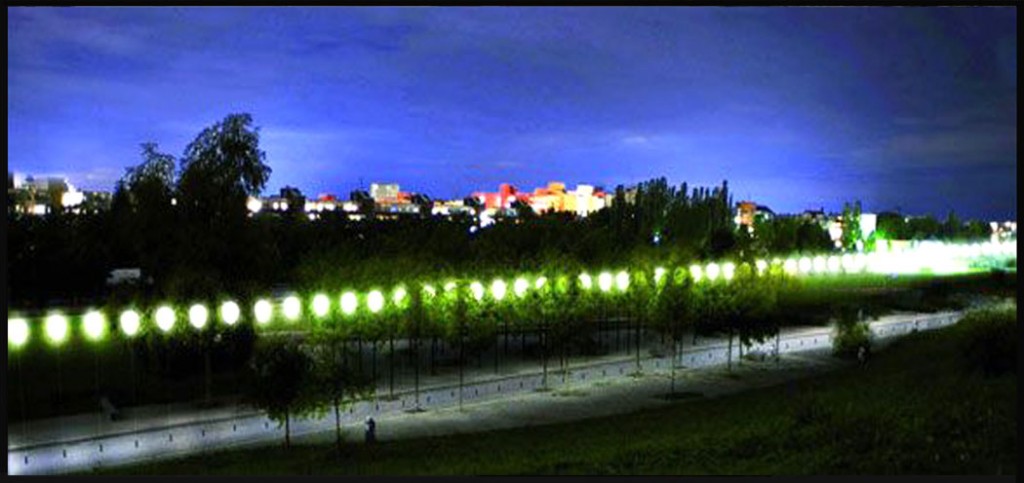 – © Kulturprojekte Berlin/Christopher Bauder
– © Kulturprojekte Berlin/Christopher Bauder
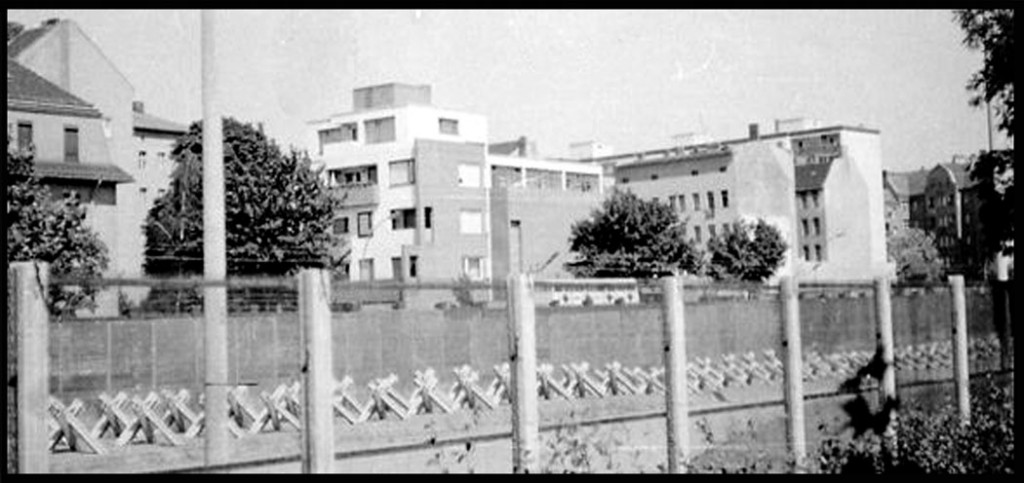 Bernauer Str. – © Detlef Peuker
Bernauer Str. – © Detlef Peuker
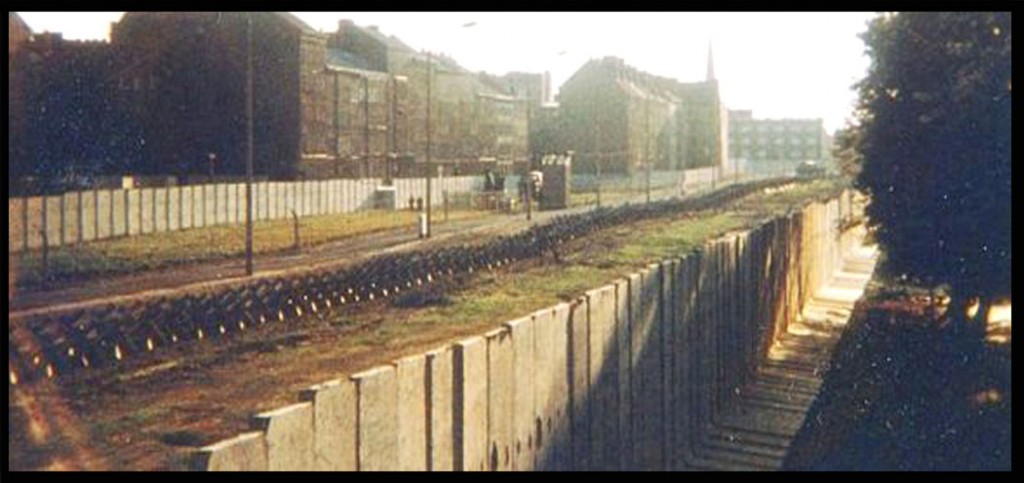 Modernization of the Berlin Wall at the Bernauer Strasse ( September 1980)
Modernization of the Berlin Wall at the Bernauer Strasse ( September 1980)
© by Yagosaga (Eckhard Etzold) at wikipedia
2014 is a historic year for Berlin. It marks the 25th anniversary of the most significant event in recent German history: the Fall of the Berlin Wall on 9 November 1989. To remember the day many exhibitions and events will take place.
One of the main highlights will be happening on the weekend around 9th November: Along the former course of the Berlin Wall a new temporary Berlin Wall will be built with thousands of illuminated balloons.
Border of Lights
To the strains of Beethoven’s Ninth Symphony in the presence of guests of honour and eyewitnesses at the Brandenburg Gate and at six other locations, white balloons will be released into the skies on the night of 9 November to commemorate the peaceful revolution of 1989 and the fall of the Berlin Wall 25 years ago.
Gathering Spots
Berliners and visitors are invited to stroll along the course of the Wall to remember and visualise the extent of the former division. At the Bornholmer Straße (9.11 only), Mauerpark, Berlin Wall Memorial and Documentation Centre, Brandenburg Gate, Potsdamer Platz, Checkpoint Charlie and East Side Gallery gathering spots, there will be information pavilions (open from 9.30am-10.00pm each day), guided tours, souvenirs, viewing platforms, catering and collages of historic images shown on giant screens.
On 8 November between 5 and 9 pm, chamber ensembles consisting of members of the European Union Youth Orchestra will be performing brief concerts at the Mauerpark, East Side Gallery and Checkpoint Charlie gathering spots. The chamber music programmes will include music from the past three centuries and reflect both the richness of European music history resist and the joy that erupted as German division came to an end 25 years ago.
There will also be guided tours along the lighting installation each day of the weekend.
Open-Air Exhibition
The open-air exhibition “100 Wall Stories” will consist of a hundred informational exhibits along the lighting installation providing background on topics such as: stories of a divided city before the Wall, the construction of the Wall in 1961, protests against the Wall, escape attempts, deaths at the Wall, border installations and inspections, everyday life in the divided city, stories of the peaceful revolution of 1989, the fall of the Wall, opening the border crossings and souvenir hunters
Philharmoniker with Sir Simon Rattle
The Berliner Philharmoniker will be presenting a special concert to mark the 25th anniversary of the fall of the Berlin Wall in the large hall of the Philharmonie on 9 November 2014.
Street Festival at the Brandenburg Gate
The Federal Government is planning a street festival around the Brandenburg Gate for 9 November, with Daniel Barenboim and the Staatskapelle as well as singers Udo Lindenberg and Peter Gabriel pulling in the crowds.
Permanent Exhibition at the Berlin Wall Memorial, Bernauer Straße
On the morning of 9 November, after a memorial service at the adjacent Chapel of Reconciliation, the new permanent exhibition “1961|1989: The Berlin Wall” will be opened at the Berlin Wall Memorial and Documentation Centre.
All of West Berlin was Surrounded
The Wall did not just go through the heart of Berlin; indeed, it completely encircled all of West Berlin, often as fenced-in no-man’s land. For the 28 years it stood, some 200 people died at the Wall. In memory of those who were killed, there will be a service held at 11.00 am on Sunday, 9 November 2014 on the former border strip newly opened as the Berliner Allee Wall Memorial (at the edge of the Schönwalde housing estate). Representatives from partner municipalities Muggensturm in Baden-Württemberg, Wagrowiec, Poland and Röderland, Brandenburg will also be present.
Another memorial along the former border will be dedicated at Groß Glienicker See/Gutspark Glienicke. The former border fence and a piece of the Wall were installed here this year as a memorial. At the 3.30 pm ceremony on 9 November 2014, the site will be opened to the public.
Not just Berlin
A quarter century after the peaceful revolution of 1989, four cities in the former East Germany (Berlin, Plauen, Dresden and Leipzig) will be holding joint commemorations of the events of autumn 1989 the weekend of 7–9 October. The Berlin commemoration will be held at the Gethesemanekirche.
Flyer 25th anniversary of the Fall of the Wall (weekend 7th of November to 9th of November)
25 Years after the Fall of the Berlin Wall
Find out more about Berlin’s most thrilling breakthrough and its impacts on mauer.visitberlin.de/en
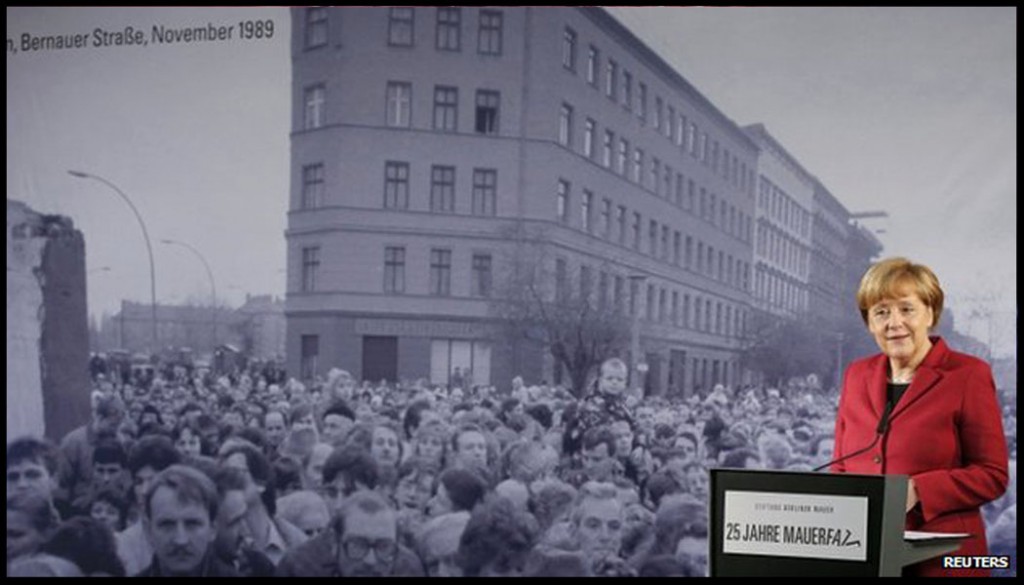
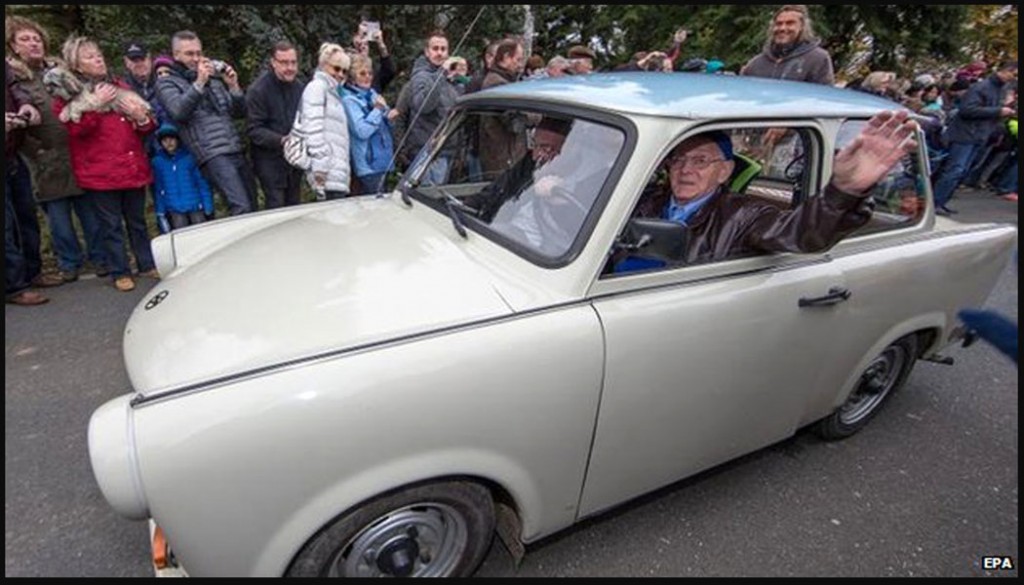
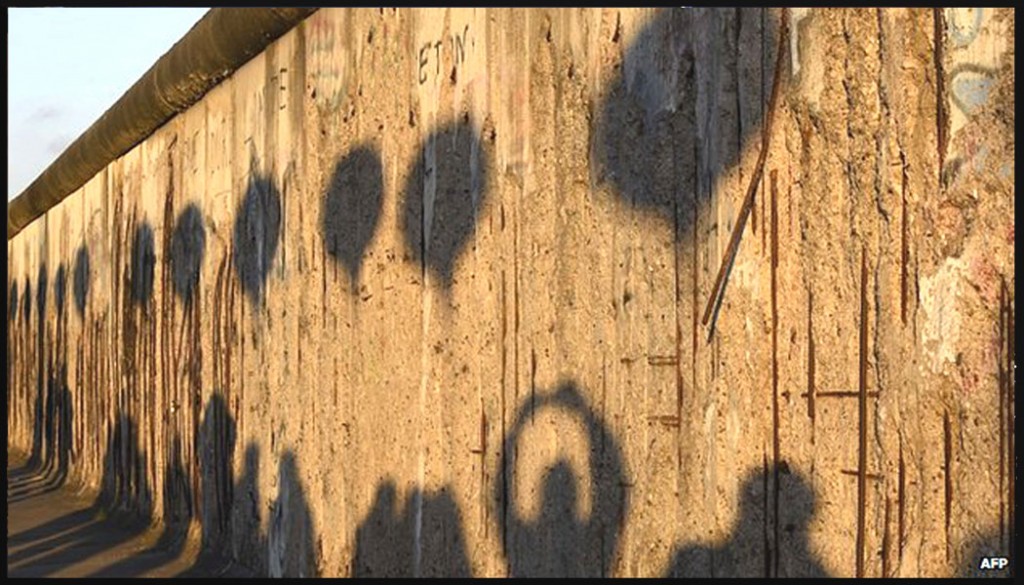
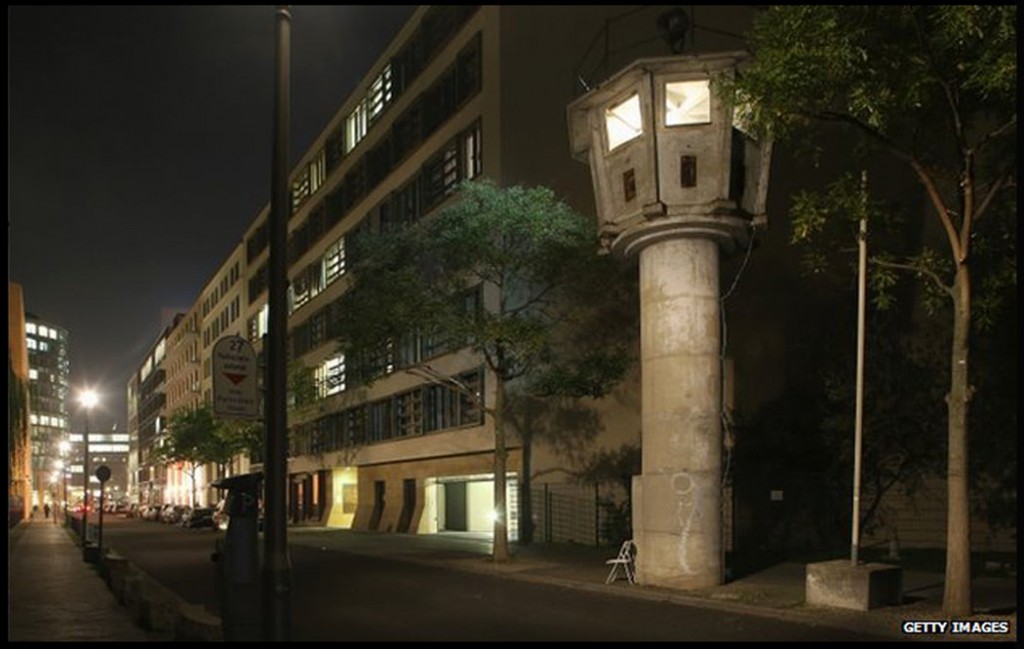

Leave a Reply